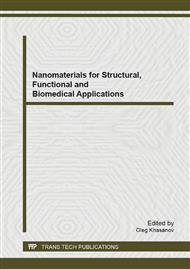[1]
S. Krol et al., Nano Lett., 6 (9) (2006) 1933–(1939).
Google Scholar
[2]
T.H.L. Nghiem1, T.H. La, X.H. Vu, et. al, Adv. Nat. Sci.: Nanosci. Nanotechnol. 1 025009 (2010) 5.
Google Scholar
[3]
V.A. Sinani, D. S. Koktysh,B. -G. Yun, R.L. Matts, T.C. Pappas, M. Motamedi, S.N. Thomas, N.A. Kotov, Nano Lett. 3 (9) (2003) 1177-1182.
DOI: 10.1021/nl0255045
Google Scholar
[4]
Y. Zhang, N. Kohler, M. Zhang, Biomaterials 23 (2002) 1553–1561.
Google Scholar
[5]
B. Kang, M. A. Mackey, M. A. El-Sayed, J. Am. Chem. Soc., 132 (2010), 1517–1519.
Google Scholar
[6]
P.C. Chen, S.C. Mwakwari, A.K. Oyelere, Nanotechnology, Science and Applications, 1 (2008) 45-66.
Google Scholar
[7]
E. E. Connor, J. Mwamuka, A. Gole, C. J. Murphy, M. D. Wyatt, Small, 1 (2005) 325–327.
Google Scholar
[8]
I. Willner, E. Katz, B. Willner, R. Blonder, V. Heleg-Shabtai and A.F. Bückmann, Biosens. Bioelectron., 12 (1997) 337–356.
DOI: 10.1016/s0956-5663(96)00065-6
Google Scholar
[9]
P. Tengvall, M. Lestelius, B. Liedberg and I. Lundstroem, Langmuir, 8 (1992) 1236–1238.
DOI: 10.1021/la00041a001
Google Scholar
[10]
H. -A. Weng, C. -C. Wu, C. -C. Chen, C. -C. Ho, S. -J. Ding, Journal of Materials Science: Materials in Medicine, 21 (5) (2010) 1511-1519.
Google Scholar
[11]
C. M. Goodman, C. D. McCusker, T. Yilmaz, V. M. Rotello, Bioconjugate Chem., 15 (2004) 897–900.
Google Scholar
[12]
A. Mocanu, I. Cernica, G. Tomoaia, L. -D. Bobos, O. Horovitz, M. Tomoaia-Cotisel, Colloids and Surfaces A: Physicochem. Eng. Aspects, 338 (2009) 93–101.
DOI: 10.1016/j.colsurfa.2008.12.041
Google Scholar
[13]
G. Sonavane, K. Tomoda, K. Makino, Colloids Surf. B, 66 (2008) 274–280.
Google Scholar
[14]
B.J. Spencer, I. M. Verma, Proc. Natl. Acad. Sci. USA, 104 (18) (2007) 7594–7599.
Google Scholar
[15]
J. Turkevich; P. C. Stevenson, J. Hillier; Discuss. Faraday Soc., 11 (1951) 55.
Google Scholar
[16]
T.B. Huff, M.N. Hansen, Y. Zhao, J.X. Cheng, A. Wei, Langmuir, 23 (2007) 1596–1599.
Google Scholar
[17]
T. Niidome, M. Yamagata, Y. Okamoto, Y. Akiyama, H. Takahashi, T. Kawano, Y. Katayama, Y. Niidome, J. Controlled Release, 114 (2006) 343–347.
DOI: 10.1016/j.jconrel.2006.06.017
Google Scholar
[18]
K.B. Male, J. Li, C.C. Bun, S. -C. Ng, J.H.T. Luong, J. Phys. Chem. C, 112 (2) (2008) 443–451.
Google Scholar
[19]
H. Takahashi, Y. Niidome, T. Niidome, K. Kaneko, H. Kawasaki, S. Yamada, Langmuir, 22 (2006), 2–5.
DOI: 10.1021/la0520029
Google Scholar
[20]
G. Sonavanea, K. Tomodaa, K. Makino, Colloids and Surfaces B: Biointerfaces 66 (2008) 274–280.
Google Scholar
[21]
S. Link and M. A. El-Sayed , Phys. Chem. B, 103 (1999) 4212-4217.
Google Scholar
[22]
R. Le´vy, N. T. K. Thanh, R. C. Doty, I. Hussain, R. J. Nichols, D. J. Schiffrin, M. Brust, and D. G. Fernig J. AM. CHEM. SOC., 126 (2004) 10076-10084.
DOI: 10.1021/ja0487269
Google Scholar
[23]
A. Majzik, R. Patakfalvi, V. Hornok and I. Dekany, Gold Bulletin Volume 42 No 2 (2009).
Google Scholar
[24]
T.H.L. Nghiem, T.H. La, X. H. Vu, V.H. Chu, T.H. Nguyen, et. al Adv. Nat. Sci.: Nanosci. Nanotechnol. 1 (2010) 025009.
Google Scholar
[25]
Yu. Petrov, Clusters and small particles, Moscow, Nauka (1982) 298.
Google Scholar
[26]
G. Mie, Ann. Phys. (Leipzig) 25, 377 (1908). U. Kreibig, M. Vollmer, Optical Properties of Metal Clusters. Berlin: Springer-Verlag (1995).
Google Scholar
[27]
V. Petranovskii, V. Gurin, N. Bogdanchikova, A. Licea-Claverie, Y. Sugi, E. Stoyanov, Mater. Sci. Eng. A332 (2002) 180.
Google Scholar
[28]
D.L. Feldheim, C.A. Foss, Jr, Metal Nanoparticles: Synthesis, Characterization and Applications, Marcel Dekker, New York (2002) 141.
Google Scholar
[29]
Yu. Ekmanis, Yu. Rud, I. Radchenko, J. Phys. Techn. Sci., 5 (1997) 3.
Google Scholar
[30]
P.B. Johnson, R.W. Christy, Phys. Rev. B, 6 (1972) 4370.
Google Scholar
[31]
Y.Q. He, L. Kong, Z.F. Liu, Spectrochemica Acta Part A, , 61, (2005) 2861.
Google Scholar
[32]
L. Marsich, A. Bonifacio, S. Mandal, S. Krol, C. Beleites, and V. Sergo Langmuir 2012, 28, 13166.
DOI: 10.1021/la302383r
Google Scholar


